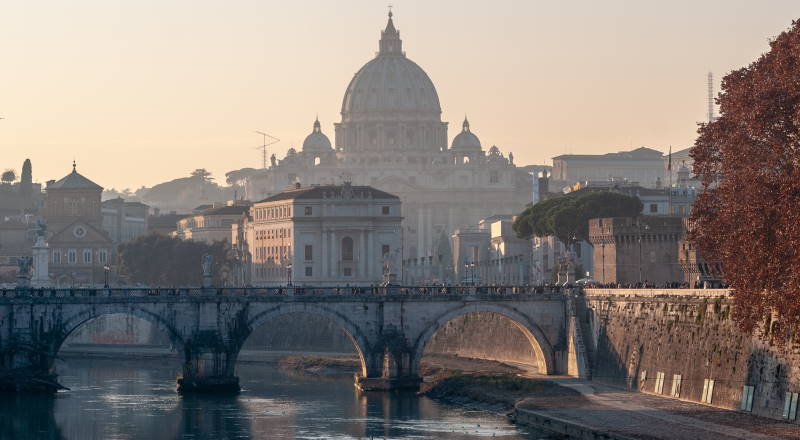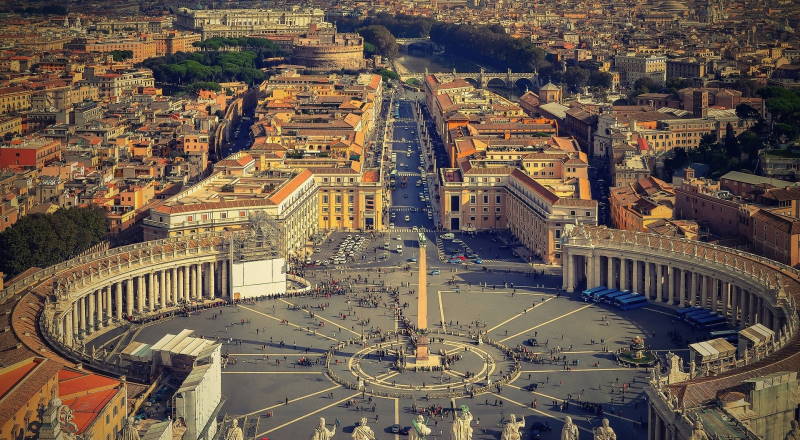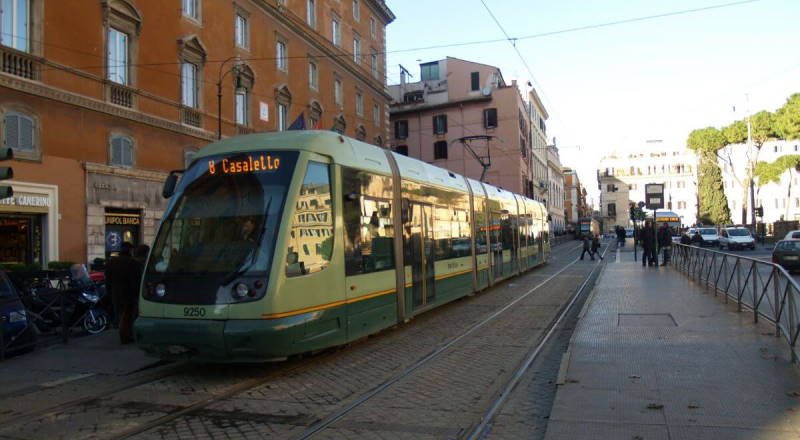Did you know?
Rome is home to more than 900 churches and 280 fountains!
In this article
Do you know what’s amazing about going on a holiday to Rome?
It’s that a Roman holiday remains a classic throughout the years. The Colosseum, Piazza di Spagna, the Pantheon, the Vatican… They never lose their charm. Not to mention the utterly romantic atmosphere!
In this article, we’ll share with you the basics (along with some pro tips and secrets) about Rome, from the best places to stay to the best things to do and eat. Scroll down!
Explore more: Rome things to do | Rome best hotels


Where do we begin to talk about Rome, the “eternal city”? For one thing, Rome in Italy has long been famed for its history and monuments. For another, this city boasts unique elegance, impeccable style, and irresistible charm!
Rome is a wonderful city worth exploring! So, keep reading our complete Rome travel guide to find out everything, from the best time to visit and where to go, to the best things to do and a bunch of useful information!

Rome is famous all around the world for its stunning architecture! The Colosseum, the Pantheon, and Trevi Fountain are some of the main attractions in Rome. In ancient times, Rome was the center of the Roman Empire that ruled the European Continent for several centuries. Today, vestiges of the Roman Empire are scattered all around the town, attracting numerous visitors every year.
Rome is located in the central part of the Italian peninsula, alongside the Tiber River, about 15 miles (24 km) away from the Tyrrhenian Sea.
Read also: Florence holidays travel guide | Naples holidays travel guide | Milan holidays travel guide | Venice holidays travel guide
The best time to visit Rome -if you want to avoid the crowds- is autumn (September to November) and spring (April to May). Although in spring there’s a chance of wind, and in autumn, there’s a chance of rain, these months are the best ones to visit Rome. That’s because during these months the city is not packed with tourists, days are long, and the weather is good -you’ll only need a light jacket on your evening strolls.
In summer, the weather is sunny, but it is often very hot, especially in the second half of summer. Despite the heat, though, hordes of tourists from all around the world flock to the city every summer to spend their summer vacation in Rome.
Autumn (September to November)
Highest: 80 F/ 27 C Lowest: 44 F/ 7 C
Winter (December to February)
Highest: 55 F/ 13 C Lowest: 38 F/ 4 C
Spring (March to May)
Highest: 73 F/ 23 C Lowest: 41 F/ 5 C
Summer (June to August)
Highest: 87 F/ 31 C Lowest: 60 F/ 15 C
Rome is home to more than 900 churches and 280 fountains!
If you’re traveling with your family, some of the best things to do in Rome are to visit the Colosseum, join a tour to an Underground House, climb up St. Peter’s Dome, go on an excursion to the Pompeii, throw some coins into the Trevi Fountain, try traditional gelato at Fatamorgana (Piazza San Cosimato), explore the Catacombs of Rome, visit the Gladiator School, and go shopping at Rome’s commercial center.
Rome is famous for its romantic atmosphere! So, if you’re visiting Rome with your spouse, some of the best things to do are a tour of the city on a horse carriage, a visit to Vatican city, a picnic at the Aventine Hill, a cruise tour through the Tiber River, a romantic walk at Villa Borghese, an opera performance at Teatro Dell’Opera di Roma, sunset gazing at Trastevere, a romantic dinner at Enoteca La Torre , city exploration on a Vespa, an helicopter tour to enjoy Rome from above, a night segway tour, and a relaxing couples massage.
Traveling solo allows you to organize your trip the way you want and explore the city at your own pace. So, if you are a solo traveler, enjoy an original Italian cappuccino or espresso at one of the city’s elegant coffee houses, get lost into the narrow streets of the city, visit the National Museums of Rome, enjoy nightlife at Trastevere, dine at a traditional Italian restaurant, visit the local markets of Rome and explore Murano, Burano and Torcello Islands.
Related: 19 Best things to do in Rome: Top attractions, places to visit & Trips you must do
Shops in Rome are typically open from 9 am to 1 pm and from 3.30 pm to 7.30 pm (4-8 pm in the summer). They are closed on Sundays and during lunch break (1 pm-3.30 pm). Grocery shops are usually closed on Thursday afternoons. Some small shops in Rome often close for two weeks to a month in summer.
On the main commercial streets in Rome, clothing stores and department stores are open from 9 am to 7.30 pm or later without closing for a lunch break. They are also open on Sundays from 10.00 am.
Population
4,257,056 (2020)
Currecy
Euro
Language
Italian
Average Temperatures
Warmest Month: July (32°C/ 90°F)
Coldest Month: January (3°C/ 37°F)
Tipping
The prices of food and beverages include tax and service (servizio) unless indicated otherwise on the menu. It is common to leave a small tip to the staff in cash to show appreciation of the good service.
Loved by
Couples, honeymooners, families, elderly, solo travelers.
Rome breathes history! No matter if you are a history nerd or you just love sightseeing, you’ll be fascinated by this city. So let’s take a peek at Rome’s enduring history! Ancient Roman culture thrived during the almost 1,200 years of Rome’s civilization. The Roman empire was one of the largest ones in history and included Europe, North Africa, and the Middle West. Ancient Rome was also multicultural and strongly influenced by its territories, like Greece.
You can get to Rome by car, plane, ferry, and train. Getting to Rome is easier if you are traveling from another European country, as there are frequent flight, train, and ferry schedules, as well as a good road network. However, flying to Rome is probably the most popular and fastest way to reach the “eternal city”!
Rome has two international airports, Fiumicino and Ciampino. Fiumicino Rome Airport (FCO) is the biggest airport in Rome and Italy. Its official name is Aeroporto Leonardo da Vinci.
The Ciampino Rome Airport (CIA) is the second-largest airport in Rome. You can easily reach them from Rome city center.
If you’re flying from the United States to Rome, you’ll find direct flights to Rome from big cities like New York, Philadelphia, Atlanta, Boston, Chicago, Miami, Los Angeles and Washington, D.C. The airline companies that fly directly from the U.S to Rome are Alitalia, Delta, Lufthansa, American Airlines, United Airlines, and KLM.
If you’re traveling from Canada to Rome, it might be more difficult for you to find direct flights, but there are still some airlines that fly directly to Rome, like Air Canada, Alitalia, Air Transat, and Air Canada Rouge. Otherwise, you can opt for flights with one or more stops, which are more frequent.
As for traveling from Australia to Rome, there aren’t any direct flights to Rome airports. However, there are indirect flights from Sydney, Adelaide, Brisbane, Melbourne, Cairns, and Perth.
Traveling to Rome from Europe is an easy and cheap way to reach the “eternal city”, as you can find tickets for less than 50 euros with low-cost airlines, like Vueling, Ryanair, Wizzair, and Easyjet.
The main port of Rome is Civitavecchia port, which is located 70 kilometers northwest of the city, at Molo Vespucci. You can easily reach Rome by ferry from Sicily, Sardinia, Tunisia, and Barcelona. The ferry companies that sail to Rome are Grimaldi Lines, Moby Lines, Tirrenia Navigazione, and Sardinia Ferries.
You can get to the port of Rome by car (via motorway A12 and highway SS1), by taxi, or by train following the rail line to Civitavecchia. The train journey from Rome city center to the port lasts from 45 minutes to 1 hour and 20 minutes. When you arrive at the Civitavecchia Rome train station, you can get a bus or a taxi to get to the port. Buses from the train station to the port run every 20 minutes and will get you to the port in about 10 minutes for 2 euros. These buses will take you to Rome Cruise Terminal, where you’ll embark on a shuttle bus that will take you to your terminal or departure quay.
Another option is to get to the port by foot from Civitavecchia Rome Train Station to Rome Cruise Terminal and then take the free shuttle bus from there.
It’s easy to get to Rome by train, as the city is well connected by train to many cities in Italy. The two main hub stations for international trains are Roma Termini and Rome Tiburtina. Roma Termini is located opposite Piazza dei Cinquecento bus station and serves international train itineraries from London and other European cities. Rome Tiburtina mainly serves national itineraries from northern and southern Italian cities like Milan, Venice, Naples, Salerno, and Turin.
Getting to Rome by car is an ideal option for those who want to make the “eternal city” part of their road trip in Italy. So, if you’re planning to visit several Italian cities by car, don’t forget to include Pisa, Monaco, Bologna, Genoa, and Florence in your itinerary.
The historic center of Rome is a must for first-time visitors, thanks to its central location, historical sites, great selection of shops, and charming atmosphere. Trastevere is another popular district for first-timers. Full of medieval streets, colorful houses, traditional trattorias, and little local shops, it has a unique charm.
Tip: For an authentic accommodation experience, we recommend that you stay at an Airbnb in Rome!
Some of the best hotels in Rome city center are: Hotel Eden, Rocco Forte Hotel De Russie, The St. Regis Rome, Villa Agrippina Gran Meliá, and Hassler Roma
San Giovanni is one of the most authentic and traditional neighborhoods in Rome -the ultimate cultural gem! Some of the best things to do in San Giovanni is to visit the Basilica di San Giovanni in Laterano, shop at the local shops and traditional neighborhood markets, and try local specialties at the cute restaurants. Monti, which is located very close to the Colosseum, is also a hip neighborhood with a retro atmosphere.
Some of the best hotels in San Giovanni are: RomAntic Dreams Guest House, Etruria Relais and Wine, Hotel San Giovanni Roma, Serventi Longhi Rooms, and The Roman Way San Giovanni
The Testaccio neighborhood in Rome offers plenty of choices, from traditional family-run trattorias to delicious pizzerias and Michelin-awarded high-end restaurants. The Jewish cooking scene is also booming in Rome, so if you want a taste of it, head to the restaurants on Via del Portico d’Ottavia.
Some of the best hotels in Testaccio are: Seven Suites, San Anselmo, The Corner Townhouse, Hotel Villa San Pio, and Hotel Aventino
One of the most romantic locations to stay in Rome is Aventine Hill, which is full of Art Nouveau Roman villas and has an elegant atmosphere. This is a quiet neighborhood, a little bit off the beaten tourist trail, which will let you enjoy a private stay at a romantic hotel in Rome! Some of the most beautiful attractions in the area are the Giardino Degli Aranci (Orange Garden) -ideal for sunset gazing and the Villa del Priorato di Malta.
Some of the best hotels in Aventine Hill are: Residenza Roma Imperiale, Colosseum Corner, Restart Accommodations Rome, Residenza Maritti ContemporarySuite, and 2 Passi Al Colosseo B&B
The main sightseeing areas in Rome are three: Ancient Rome, the historic center of Rome, and the Vatican. The Ancient Rome area stretches around the Colosseum and includes some of the most important landmarks of the city. The historic center is very popular with tourists who want to combine shopping with sightseeing in Rome. It includes attractions like the Pantheon and Trevi Fountain. The Vatican is another super-famous spot. Inside the Vatican, you’ll find important monuments like the St Peter’s Basilica and the Vatican Museums.
Some of the best hotels in Vatican are: Al Ponte Del Papa B&B, Restart Accommodations Rome, Vatican Style, NH Collection Roma Giustiniano, and Trianon Borgo Pio Aparthotel
Trastevere is a one-way destination for crazy nightlife in Rome, as it is packed with many bars, nightclubs, and cafes. The heart of the city’s nightlife also beats at Rome’s historic center, where you’ll find a selection of pubs, rooftop bars, discos, and risto-bars. Alternatively, you can opt for San Lorenzo, or Pigneto, a hip bar hub east of the Termini station.
Some of the best hotels to stay in Trastevere are: Horti 14 Borgo Trastevere, Hotel Santa Maria, VOI Donna Camilla Savelli Hotel, Tree Charme, and Trastevere Royal Suite Trilussa
Related: Rome best hotels and places to stay
Rome might be an ideal city for walking, but you can’t go everywhere on foot. That’s why the public means of transportation are your best friend! Let’s see the best ways to get around Rome in detail.

One of the most important things you should know before your trip to Rome is that you’re going to walk -a lot! So, don’t forget to pack a pair or two of comfortable shoes and get free city maps at municipal information booths. If your destination is far and you don’t want to walk, there’s always the option of getting a taxi, which is rather pricey.
The Metro is the most popular and easiest way to get around Rome, as there are many metro stations near all the main tourist attractions. The Metro lines in Rome are three: A and B, which connect at Termini station, and C.
Linea A (the red line) starts from the eastern part of Rome and makes stops at Piazza Barberini, Piazza di Spagna, Piazzale Flaminio (Piazza del Popolo), and Ottaviano/San Pietro, which is close to the Basilica di San Pietro and the Musei Vaticani.
Linea B (the blue line) makes stops near the Colosseum, the Circus Maximus, the Pyramid, and the Basilica di San Paolo Fuori le Mura.
Linea C starts from the eastern outskirts of the city through Pigneto.
The Metro is open from 5:30 am to 11:30 pm, when the last train leaves. On Friday and Saturday nights the last trains on the A and B lines leave at 1:30 am.
The bus and the tram are the second most popular public means of transportation in Rome. The bus isn’t as fast as the metro, but it offers amazing views of the city. Buses and trams have different colors. ATAC city buses are orange, gray-and-red, or blue-and-orange, while the trams are orange or green.
Keep in mind that you should board from the front door and exit from the middle door and validate your ticket at the bus entrance. Buses and trams run from 5:30 in the morning until midnight.
A ticket for the public means of transportation in Rome costs 1.50 euros and is valid for 100 minutes for transportation via buses, trams, and the Metro. You can purchase tickets at tobacco shops, newsstands, some coffee shops, automatic ticket machines at Metro stations, ATAC ticket booths, and bus stops. Although you can purchase a single ticket, we recommend buying a few, so you can get around without delays.
Alternatively, you can purchase a Roma24H ticket, or biglietto integrato giornaliero (integrated daily ticket). This ticket costs 7 euros and is valid for 24 hours starting from your first validation. You can also purchase a Roma 48H ticket, which is valid for 48 hours and costs 12.50 euros, a Roma 72H ticket, which lasts for 72 hours and costs 18 euros, and a CIS (Carta Integrata Settimanale), which is valid for one week and costs 24 euros. All tickets grant admission to ATAC buses, COTRAL urban bus services, trains for the Lido and Viterbo, and Metro.
If you’re planning to stay in Rome for more than a week, your best bet is to get a BIRG (daily regional ticket) or a CIRS (weekly regional ticket) from the railway station. With these tickets, you can move around using all state transport throughout the region of Lazio.
If you want to get around Rome at your own pace or go on road trips to nearby towns and villages, the car is the best option. Find below some facts about driving in Rome:
Documents required:
How much money you’re going to spend each day in Rome depends on your overall budget, but in general, if you are a mid-range or budget-conscious traveler, you should plan to spend around 130 euros (141 $) per day. This amount of money includes accommodation, food, and drink, as well as public transportation tickets.
Pizza is hands down the trademark dish of the Italian cuisine. Pizza in Rome doesn’t only refer to the classic version of the Italian specialty, but also a variety of flatbreads and small round pizzas. You can get a whole pizza or pizza al taglio (pizza by the slice), which is a better option if you are on the go. Depending on the restaurant, pizza may be served folded or on a tray, usually freshly garnished with basil. Yum!
This is another super-famous local specialty! The basic ingredient of this dish is pasta (spaghetti or rigatoni), which is topped with a mix of guanciale or pancetta, a creamy sauce of egg yolks or whole eggs, pecorino cheese or Parmigiano-Reggiano cheese, and sprinkled pepper.
Gelato (the Italian ice cream) is nothing like the ice creams you’ve tasted before! Italian gelaterias hide in every corner of Rome, so finding traditional gelato is the easiest thing! Even though there is a wide selection of gelato shops, some of the best ones are Neve di Latte, I Caruso, Otaleg, Fatamorgana, and Fior di Luna.
This is the ultimate dish for meat lovers! Osso buco alla Milanese consists of tender veal shanks, braised in white wine and served with a side of vegetables and aromatic garlicky gremolata, a sauce made with lemon zest, garlic, and parsley.
Even though there aren’t any special health risks regarding traveling to Rome, we advise you to have a European Health Insurance Card (EHIC), so that you can receive free treatment in case you need it. In general, hospitals in Rome are well equipped and medical staff is well trained, so health care shouldn’t bother you.
Vaccinations for mumps, pertussis, measles, rubella, polio, pneumococcal, and hepatitis B are recommended by the World Health Organization.
Water is safe to drink in Rome, except for some rural areas, where it is better to stick to bottled water.
Meat, fish, vegetables, and fruits are all safe to consume in Rome.
Milk and dairy are pasteurized and safe to consume.
Summer in Rome is pretty hot, so make sure you pack light and breathable clothing like cotton t-shirts, sundresses, and linen pants. Opt for natural fabrics that absorb sweat, leaving your skin dry. Also, pack comfortable sandals or breathable sneakers for all the walking you’re going to do in Rome.
Autumn weather in Rome is neither too hot nor too cold, so it’s ideal for exploration. However, be prepared for rain, especially in November, which is the rainiest month in Rome. For a fall holiday in Rome, pack some light summer clothes for mornings and some long-sleeve shirts and light jackets for nights, when the temperature drops. Oh, and don’t forget your raincoat!
Winter is the coldest season of the year in Rome, so clothes have to be warm. Days can still be sunny, but nights are quite crisp, so don’t forget to pack a warm coat, a pair of leather boots, a pair of gloves, a scarf, and sweaters.
Spring weather in Rome is wonderful! It is sunny in general, but you should expect rain as well as temperature fluctuations, so smart packing is the key. Don’t forget to pack a medium-weight jacket, long-sleeve shirts, comfortable trousers, a raincoat, and a scarf to be prepared for any weather condition.
Do you have any tips or recommendations about travelling to Rome? Tell us in the comments! If you liked this article, don’t forget to share it on Social Media!
Other Travel Guides you may be interested in: Florence holidays travel guide | Venice holidays travel guide | Milan holidays travel guide | Naples holidays travel guide | London holidays travel guide | Paris holidays travel guide | Amsterdam holidays travel guide | Tokyo holidays travel guide

Your email address will not be published. Required fields are marked.*